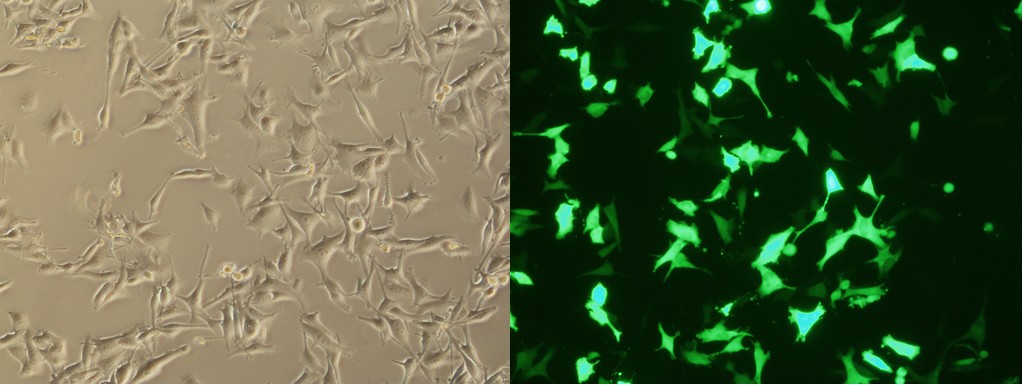Description
Cell to transfect:
Designations: B16-F10
Cell Synonyms: : B16, F10, B16F10, CRL-6475, mouse melanoma cell
Organism: Mus musculus (mouse)
Strain: C57BL/6J
Tissue: melanoma; skin
Growth properties: adherent
Morphology: mixture of spindle-shaped and epithelial-like cells
Depositors: Naval Biosciences Laboratory
Features of the The Transfection Reagent:
- Broad spectrum for the transfection of large plasmid, mRNA, siRNA, and/or other type of nucleic acids, which is best for co-transfection of different type and/or size of nucleic acids.
- Unique formulation-maximize transfection performance in B16-F10 cells.
- Extremely gentle to cells
- 0.5 ml is able to transfect about 1000 wells of 24-well plate
- Compatible with serum
- Suitable for Reverse Transfection
- Compatible with transfection in any plate formats
- Economical: High efficiency means less amount of nucleic acid & reagent is needed
- Developed and manufactured by EZ Biosystems
Data
 FIG. 1. High throughput test of transfection efficiency (determined as RLU/mg) on B16-F10 cells after transfection of luciferase reporter gene by using our 172 proprietary transfection formulas and several most popular commercial transfection reagents. The yellow box showed the results of 4 commercial transfection reagents. The red lines marked our candidate formulas with the highest transfection efficiency for B16-F10 cells. This test result was confirmed with repeat experiments. The one that showed the optimal balance of potent & low cytotoxicity among those candidate formulas after flow cytometry analysis on the percentage of 7AAD positive cells was later named as this B16-F10 Cell Avalanche Transfection Reagent.
FIG. 1. High throughput test of transfection efficiency (determined as RLU/mg) on B16-F10 cells after transfection of luciferase reporter gene by using our 172 proprietary transfection formulas and several most popular commercial transfection reagents. The yellow box showed the results of 4 commercial transfection reagents. The red lines marked our candidate formulas with the highest transfection efficiency for B16-F10 cells. This test result was confirmed with repeat experiments. The one that showed the optimal balance of potent & low cytotoxicity among those candidate formulas after flow cytometry analysis on the percentage of 7AAD positive cells was later named as this B16-F10 Cell Avalanche Transfection Reagent.
 FIG. 2. B16-F10 cells were transfected with GFP vector (pEGFP-N3) by using B16-F10 Avalanche® Transfection Reagent. The cells were visualized by Nikon Eclipse Fluorescence microscope 24 hours post transfection.
FIG. 2. B16-F10 cells were transfected with GFP vector (pEGFP-N3) by using B16-F10 Avalanche® Transfection Reagent. The cells were visualized by Nikon Eclipse Fluorescence microscope 24 hours post transfection.
For Other Cells
B16-F10 Cell Avalanche® Transfection Reagent (mouse melanoma cell) can also be used on the following cells with high transfection efficiencies.
Caki-1 Cell
MDCK Cell
Vero Cell
293 Cell
PC-3 Cell
AR42J Cell
Capan-1 Cell
PANC-1 Cell
BxPC-3 Cell
AsPC-1 Cell
Recommended protocols for these cells will be provided with the reagent. The protocols usually provide satisfactory transfection efficiency with invisible cytotoxicity. However, optimization may be needed for certain type of cells. Optimizations may include: the amount of DNA and this transfection reagent; cell density; transfection reagent/DNA ratio, or incubation time for the mixture of transfection reagent/DNA etc. For best transfection result, we recommend using the respective cell type/cell line specific Avalanche transfection reagents. Those reagents have been optimized on both recipes and protocols, and have been proved to have the best transfection results for the respective cell lines or primary cells. You can easily find the respective Avalanche transfection reagents specific for your cells by using the filters of our product list.
Additional Information
| Weight | 0.5 lbs |
|---|---|
| Adherence Phenotype |
Adherent |
| Cell Type |
Others |
| Disease |
Cancer |
| Names starting from |
B |
| Primary/Cell Line |
Cell Line |
| Product Sizes |
0.5 ml, 1.5 ml |
| Species |
Mouse |
| Tissue Sources |
Melanoma |
| Subcategories |
Cell Type/Cell Line Specific |
Documents
Protocols
MSDS
Citations or Feedback


